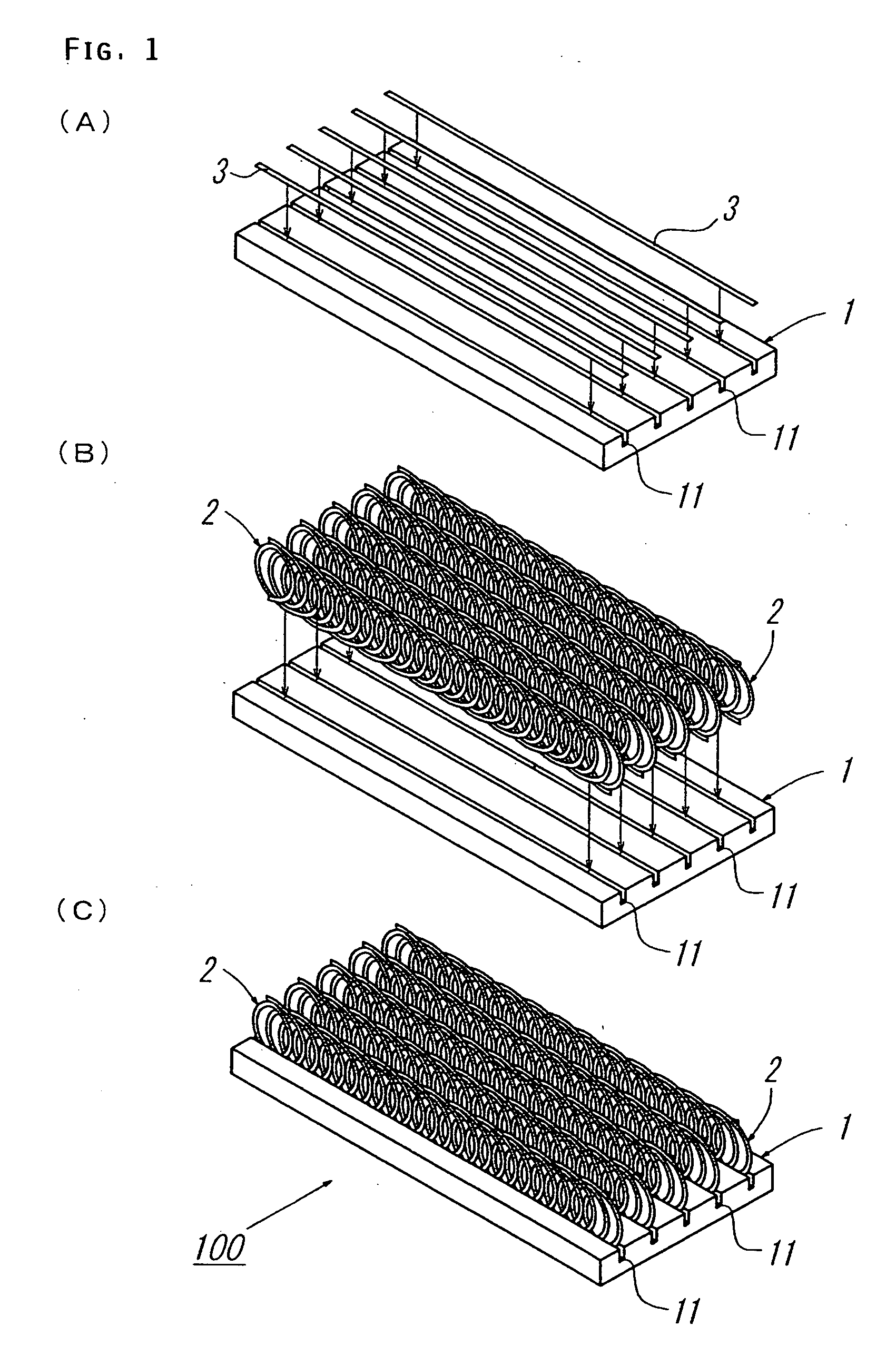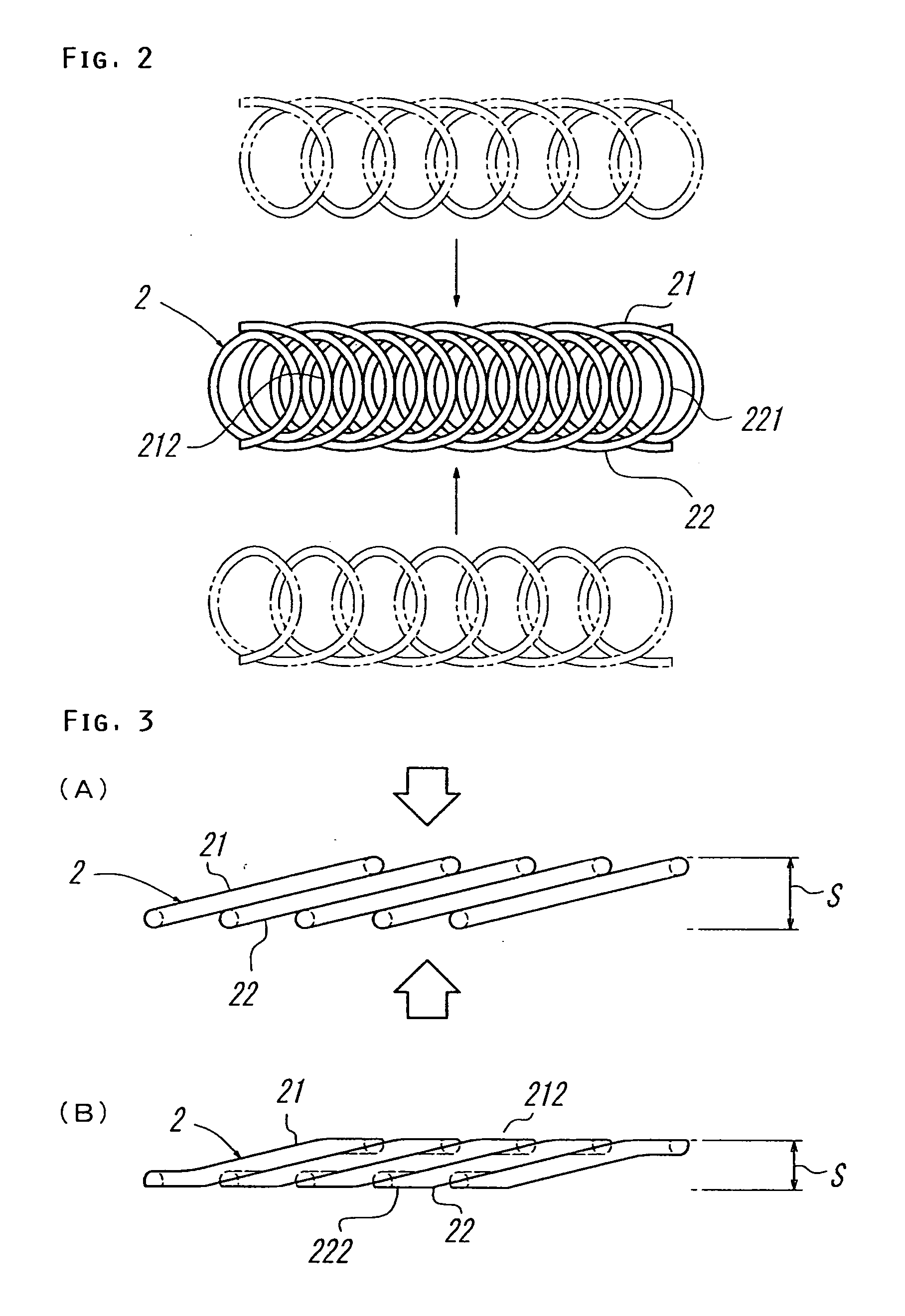Method for Manufacturing a Heat Sink
a heat sink and manufacturing method technology, applied in the direction of lighting and heating apparatus, laminated elements, instruments, etc., can solve the problems of weak fixing strength of insufficient heat conduction from the radiating substrate to the radiating fin, and inability to enhance the fixing strength and heat conductivity between the radiating substrate and the radiating fin, etc., to achieve the effect of enhancing the fixing strength and heat conductivity
- Summary
- Abstract
- Description
- Claims
- Application Information
AI Technical Summary
Benefits of technology
Problems solved by technology
Method used
Image
Examples
first embodiment
[0048]FIG. 1 through FIG. 6 illustrate the best mode for practicing the method for manufacturing the heat sink according to the invention.
[0049] The heat sink in the first embodiment comprises a radiating substrate 1 and radiating fins 2, which are united by soldering.
[0050] The radiating substrate 1 is formed of a flat plate having high thermal conductivity. To be more specific, it may be made from metallic material such as aluminum, copper, silver and gold or carbon material. As the metallic material, there may be used an alloy of such a metallic material and nickel, magnesium, zinc or silicon. As the occasion demands, it may be subjected to surface treatment with a material having no significant adverse effect on soldering to increase heat conductivity and corrosion resistivity. There are formed slit-like insertion grooves 11 in one surface of the radiating substrate 1 (opposite surface of a mounting surface to be attached to a semiconductor device). The insertion groove 11 may ...
second embodiment
[0064]FIG. 7 shows the best mode for practicing the method for manufacturing the heat sink 100 according to the invention.
[0065] In this second embodiment, the radiating substrate 1 and radiating fins 2 are secured with thermally-conductive adhesive 4.
[0066] The radiating substrate 1 and radiating fins 2 are the same as those in the first embodiment.
[0067] The thermally-conductive adhesive 4 is made by mixing metal powder such as of gold, silver, nickel or the like and / or power of alumina, alumina nitride, silicon nitride, carbon or the like with a binder such as of epoxy resin, silicon resin, acrylate resin, urethane resin or the like.
[0068] The thermally-conductive adhesive 4 may be sprayed intensively onto the insertion grooves 11 in the radiating substrate 1 by using a nozzle 5 as shown in FIG. 7(A).
[0069] The other function and effect of the second embodiment are much the same as the first embodiment processed by soldering, exclusive of the difference between the solder 3 a...
third embodiment
[0073] In the third embodiment as shown in FIG. 8, after inserting the radiating fins 2 into the insertion grooves 11 in the radiating substrate 1, the insertion groove 11 in the radiating substrate 1 is deformed by calking under pressure in the width direction to unite the radiating fins 2 to the radiating substrate 1.
[0074] In the third embodiment, the side edge portions 213 and 223 having the complex uneven surfaces of the coils 21 and 22 of the radiating fins 2 fitted into the insertion grooves 11 are more intricately deformed as the insertion grooves 11 in the radiating substrate 1 are deformed. Thus, the punctate contact portions between the flat surface of the radiating substrate 1 and the curved portions of the radiating fins 2 are significantly enlarged consequently to increase the strength of the union between the radiating substrate 1 and radiating fins 2 and improve the heat conductivity between the radiating substrate 1 and the radiating fins 2.
PUM
 Login to view more
Login to view more Abstract
Description
Claims
Application Information
 Login to view more
Login to view more - R&D Engineer
- R&D Manager
- IP Professional
- Industry Leading Data Capabilities
- Powerful AI technology
- Patent DNA Extraction
Browse by: Latest US Patents, China's latest patents, Technical Efficacy Thesaurus, Application Domain, Technology Topic.
© 2024 PatSnap. All rights reserved.Legal|Privacy policy|Modern Slavery Act Transparency Statement|Sitemap



